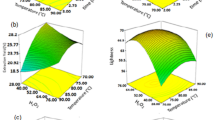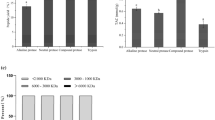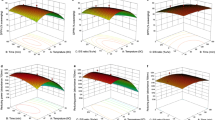Abstract
Soy whey is generated as a process waste while preparing soy based food products tofu, causing environmental pollution and also representing an economic penalty against the industrial process. Therefore, its valorization is of prime importance to the industry. The present investigation aims to convert this proteinaceous waste into bioactive peptide enriched hydrolysate. Soy whey protein was enzymatically treated with the Aspergillus awamori nakazawa protease. Respective protease was efficient to produce antioxidant peptide beholding radical scavenging ability of 40–50% at normal conditions. Remarkable increase in the radical scavenging activity upto 70% was noticed at the response surface methodology (RSM) based optimized condition: temperature 40°C, salt concentration (NaCl) 0.05 M, surfactant concentration (Triton-X 100) 0.0075%, hydrolysis time 80 min, and enzyme to substrate concentration 164 IU/g of soy whey protein. The present study emphasizes the biotransformation of proteineceous waste into antioxidant peptide rich soy whey protein hydrolysate to be considered as additives for food preparation and formulation.
Similar content being viewed by others
References
Damodaran S. Food proteins: an overview. pp. 1–21. In: Food Proteins and Their Applications. Damodaran S, Paraf A (eds). Marcel Dekker, New York, NY, USA (1997)
Fung WY, Woo YP, Liong MT. Optimization of growth of Lactobacillus acidophilus FTCC 0291 and evaluation of growth characteristics in soy whey medium: A response surface methodology approach. J. Agr. Food Chem. 56: 7910–7918 (2008)
Moure A, Domínguez H, Parajó J. Antioxidant properties of ultrafiltration-recovered soy protein fractions from industrial effluents and their hydrolysates. Process Biochem. 41: 447–456 (2006)
Fung WY, Liong MT. Evaluation of proteolytic and ACE-inhibitory activity of Lactobacillus acidophilus in soy whey growth medium via response surface methodology. LWT-Food Sci. Technol. 43: 563–567 (2010)
Kitts DD, Weiler K. Bioactive proteins and peptides from food sources. Applications of bioprocesses used in isolation and recovery. Curr. Pharm. Design 9: 1309–1323 (2003)
Udenigwe CC, Aluko RE. Food protein-derived bioactive peptides: Production, processing, and potential health benets. J. Food Sci. 71: R11–R24 (2012)
Hartmann R, Meisel H. Food-derived peptides with biological activity: From research to food applications. Curr. Opin. Biotech. 18: 163–169 (2007)
Korhonen H. Milk derived bioactive peptides: From science to applications. J. Funct. Foods 1: 177–187 (2009)
Wang W, Gonzalez-de-Mejia E. A new frontier in soy bioactive peptides that may prevent age-related chronic diseases. Compr. Rev. Food Sci. F. 4: 63–78 (2005)
Clemente A. Enzymatic protein hydrolysates in human nutrition. Trends Food Sci. Tech. 11: 256–262 (2000)
Dey S, Dora K. Antioxidative activity of protein hydrolysate produced by alcalase hydrolysis from shrimp waste (Penaeus monodon and Penaeus indicus). J. Food Sci. Tech. 49: 1–9 (2012)
Naqash SY, Nazeer RA. Optimization of enzymatic hydrolysis conditions for the production of antioxidant peptides from muscles of Nemipterus japonicus and Exocoetus volitans using response surface methodology. Amino Acids 43: 337–345 (2012)
Wu S, Sun J, Tong Z, Lan X, Zhao Z, Liao D. Optimization of hydrolysis conditions for the production of angiotensin-I converting enzyme-inhibitory peptides and isolation of a novel peptide from lizard fish (Saurida elongata) muscle protein hydrolysate. Mar. Drugs 10: 1066–1080 (2012)
Ren J, Lin WT, Shen YJ, Wang JF, Luo XC, Xie MQ. Optimization of fermentation media for nitrite oxidizing bacteria using sequential statistical design. Bioresource Technol. 99: 7923–7927 (2008)
Rahulan RJ, Nampoothiri KM, Szakacs G, Szakacs G. Statistical optimization of L-leucine amino peptidase production from Streptomyces gedanensis IFO 13427 under submerged fermentation using response surface methodology. Biochem. Eng. J. 43: 64–71 (2009)
Cao W, Zhang C, Ji H, Hao J. Optimization of peptic hydrolysis parameters for the production of angiotensin I-converting enzyme inhibitory hydrolysate from Acetes chinensis through Plackett-Burman and response surface methodological approaches. J. Sci. Food Agr. 92: 42–48 (2012)
Zhuang Y, Zhao X, Li B. Optimization of antioxidant activity by response surface methodology in hydrolysates of jellyfish (Rhopilema esculentum) umbrella collagen. J. Zhejiang Univ. Sci. B. 10: 572–579 (2009)
Vaštag Z, Popoviæ L, Popoviæ S, Krimer V, Perièin D. Hydrolysis of pumpkin oil cake protein isolate and free radical scavenging activity of hydrolysates: Influence of temperature, enzyme/substrate ratio, and time. Food Bioprod. Process. 88: 277–282 (2010)
Pihlanto A. Antioxidative peptides derived from milk proteins. Int. Dairy J. 16: 1306–1314 (2006)
Zhu K, Zhou H, Qian H. Antioxidant and free radical-scavenging activities of wheat germ protein hydrolysates (WGPH) prepared with alcalase. Process Biochem. 41: 1296–1302 (2006)
Gulati T, Chakrabarti M, Singh A, Duvuuri M, Banerjee R. Comparative studies on RSM and ANN-GA for optimization of soybean hydration. Food Technol. Biotech. 48: 11–18 (2010)
Osho SM. Developed Soyabean Technologies for Small-scale and Industrial Levels. A manual workshop on small-scale and industrial level processing of soyabean. Ibadan, Nigeria (1993)
Chakrabarti M, Gulati T, Singh A, Duvuuri M, Banerjee R. Modeling and optimization of nutritionally enriched soy whey generation. J. Food Process. Eng. 34: 1775–1792 (2011)
Negi S, Banerjee R. Optimization of amylase and protease production from Aspergillus awamori nakazawa in single bioreactor through EVOP factorial design technique. Food Technol. Biotech. 44: 257–261 (2006)
Hernández-Ledesma B, Miralles B, Amigo L, Ramos M, Recio I. Identification of antioxidant and ACE-inhibitory peptides in fermented milk. J. Sci. Food Agr. 85: 1041–1048 (2005)
Ou S, Kwok KC, Kang Y. Changes in in vitro digestibility and available lysine of soy protein isolate after formation of film. J. Food Eng. 64: 301–305 (2004)
Singh S, Singh RP. In vitro methods of assay of antioxidants: An overview. Food Rev. Int. 24: 392–415 (2008)
Evans EC, Abdullahi A. Effect of surfactant inclusions on the yield and characteristics of protease from Bacillus subtilis. Proc. Rom. Acad. 2: 108–112 (2012)
Singh SK, Singh SK, Tripathi VR, Garg SK. An oxidant, detergent, and salt stable alkaline protease from Bacillus cereus SIU1. Afr. J. Biotechnol. 10: 12257–12264 (2011)
Negi S, Banerjee R. Characterization of amylase and protease produced by Aspergillus awamori in a single bioreactor. Food Res. Int. 42: 443–448 (2009)
Golovanov AP, Hautbergue GM, Wilson SA, Lian LY. A simple method for improving protein solubility and long-term stability. J. Am. Chem. Soc. 126: 8933–8939 (2004)
Bougatef A, Nedjar-Arroume N, Manni L, Ravallec R, Ahmed B, Guillochon D, Nasri M. Purification and identification of novel antioxidant peptides from enzymatic hydrolysates of sardinelle (Sardinella aurita) byproducts proteins. Food Chem. 118: 559–565 (2010)
Liu Q, Kong B, Xiong YL, Xia X. Antioxidant activity and functional properties of porcine plasma protein hydrolysate as influenced by the degree of hydrolysis. Food Chem. 118: 403–410 (2010)
Author information
Authors and Affiliations
Corresponding author
Rights and permissions
About this article
Cite this article
Singh, A., Banerjee, R. Peptide enriched functional food adjunct from soy whey: A statistical optimization study. Food Sci Biotechnol 22 (Suppl 1), 65–71 (2013). https://doi.org/10.1007/s10068-013-0050-8
Received:
Revised:
Accepted:
Published:
Issue Date:
DOI: https://doi.org/10.1007/s10068-013-0050-8




